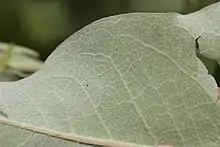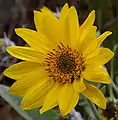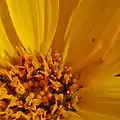| Balsamorhiza sagittata | |
|---|---|
 | |
| Balsamorhiza sagittata
(near Horselake, Chelan County, Washington) | |
| Scientific classification | |
| Kingdom: | Plantae |
| Clade: | Tracheophytes |
| Clade: | Angiosperms |
| Clade: | Eudicots |
| Clade: | Asterids |
| Order: | Asterales |
| Family: | Asteraceae |
| Genus: | Balsamorhiza |
| Species: | B. sagittata |
| Binomial name | |
| Balsamorhiza sagittata | |
 | |
| Distribution in North America | |
| Synonyms[1] | |
| |
Balsamorhiza sagittata is a North American species of flowering plant in the tribe Heliantheae of the family Asteraceae known by the common name Arrowleaf Balsamroot. Also sometimes called Oregon sunflower,[2][3] it is widespread across western Canada and much of the western United States.[4]
Description

This is a taprooted perennial herb growing a hairy, glandular stem 20 to 60 centimetres (7+3⁄4 to 23+1⁄2 inches) tall, with the plant's total height up to 80 cm (31 in).[5] The branching, barky root may extend over 2 metres (6+1⁄2 feet) deep into the soil. The silvery-gray basal leaves[5] are generally triangular in shape and large, approaching 50 cm (20 in) in maximum length. Leaves farther up the stem are linear to narrowly oval in shape and smaller. The leaves have untoothed edges and are coated in fine to rough hairs, especially on the undersides.[6][7][8][9]
The inflorescence bears one or more flower head, sometimes more than one on the same stem,[10] blooming from May to July.[5] Each head has a center of long yellowish tubular disc florets and a fringe of 8–25 bright yellow ray florets, each up to 4 cm (1+1⁄2 in) long.[5] The fruit is a hairless achene about 8 millimetres (3⁄8 in) long.[11]
B. deltoidea is similar but is greener, less hairy, and does not retain its ray flowers for long.[5]
Distribution and habitat
The plant's native range extends from British Columbia and Alberta in the north, southward as far as northern Arizona and the Mojave Desert of California, and as far east as the Black Hills of South Dakota.[4] It grows in many types of habitat from mountain forests to grassland to desert scrub.[12][13] It is drought tolerant.[14]
Ecology
The species hybridizes with Balsamorhiza hookeri.[10]
Grazing animals find the plant palatable, especially the flowers and developing seed heads.[11] Elk and deer browse the leaves.[15]
Uses
Coming into season in late spring, all of the plant can be eaten—particularly the leaves (raw or cooked), roots (cooked), and the seeds, raw or pounded into flour.[14][16] It can be bitter and pine-like in taste.[17] The leaves are best collected when young and can carry a citrus flavor.[18]
Many Native American groups, including the Nez Perce, Kootenai, Cheyenne, and Salish, utilized the plant as a food and medicine.[19][11] The seeds were particularly valuable as food or used for oil.[20] In 1806, William Clark collected a specimen near the White Salmon River, and both he and Frederick Pursh noted that the stem was eaten raw by the American natives.[18]
Culture
A specimen was collected by explorer and botanist Meriwether Lewis near Lewis and Clark Pass in 1806.[21]
Under the name Okanagan Sunflower, it is the official flower emblem of the city of Kelowna, British Columbia, Canada.[22]
Gallery
 Balsamorhiza sagittata flower head
Balsamorhiza sagittata flower head Balsamorhiza sagittata insect predation
Balsamorhiza sagittata insect predation Balsamorhiza sagittata involucre.
Balsamorhiza sagittata involucre. Balsamorhiza sagittata
Balsamorhiza sagittata Balsamorhiza sagittata in Grand Teton National Park, Wyoming, US
Balsamorhiza sagittata in Grand Teton National Park, Wyoming, US_Whole_Plant_in_East_Knox_Mountain_Park.png.webp) Balsamorhiza sagittata in East Knox Mountain Park, British Columbia, Canada.
Balsamorhiza sagittata in East Knox Mountain Park, British Columbia, Canada. Balsamorhiza sagittata seedling
Balsamorhiza sagittata seedling Balsamorhiza sagittata leaves sprouting from mature plant in early spring
Balsamorhiza sagittata leaves sprouting from mature plant in early spring Balsamorhiza sagittata mature seed heads in June
Balsamorhiza sagittata mature seed heads in June Balsamorhiza sagittata mature seed head
Balsamorhiza sagittata mature seed head Balsamorhiza sagittata seeds
Balsamorhiza sagittata seeds Balsamorhiza sagittata dry plants in fall that are dormant
Balsamorhiza sagittata dry plants in fall that are dormant.jpg.webp) Bright orange-yellow petals are a distinguishing characteristic of Balsamorhiza sagittata
Bright orange-yellow petals are a distinguishing characteristic of Balsamorhiza sagittata
References
- ↑ "Balsamorhiza sagittata (Pursh) Nutt.". The Global Compositae Checklist (GCC) – via The Plant List. Note that this website has been superseded by World Flora Online
- ↑ "Herb: Oregon Sunflower".
- ↑ "Balsamorhiza sagittata - (Pursh.)Nutt".
- 1 2 "Balsamorhiza sagittata". County-level distribution map from the North American Plant Atlas (NAPA). Biota of North America Program (BONAP). 2014.
- 1 2 3 4 5 Spellenberg, Richard (2001) [1979]. National Audubon Society Field Guide to North American Wildflowers: Western Region (rev ed.). Knopf. pp. 358–359. ISBN 978-0-375-40233-3.
- ↑ Klinkenberg, Brian, ed. (2014). "Balsamorhiza sagittata". E-Flora BC: Electronic Atlas of the Plants of British Columbia [eflora.bc.ca]. Lab for Advanced Spatial Analysis, Department of Geography, University of British Columbia, Vancouver. Retrieved 2015-02-07.
- ↑ Giblin, David, ed. (2015). "Balsamorhiza sagittata". WTU Herbarium Image Collection. Burke Museum, University of Washington. Retrieved 2015-02-07.
- ↑ Keil, David J. (2012). "Balsamorhiza sagittata". In Jepson Flora Project (ed.). Jepson eFlora. The Jepson Herbarium, University of California, Berkeley. Retrieved 2015-02-07.
- ↑ Weber, William A. (2006). "Balsamorhiza sagittata". In Flora of North America Editorial Committee (ed.). Flora of North America North of Mexico (FNA). Vol. 21. New York and Oxford: Oxford University Press – via eFloras.org, Missouri Botanical Garden, St. Louis, MO & Harvard University Herbaria, Cambridge, MA.
- 1 2 Taylor, Ronald J. (1994) [1992]. Sagebrush Country: A Wildflower Sanctuary (rev. ed.). Missoula, MT: Mountain Press Pub. Co. pp. 146, 148. ISBN 0-87842-280-3. OCLC 25708726.
- 1 2 3 McWilliams, Jack (2002). "Balsamorhiza sagittata". Fire Effects Information System (FEIS). US Department of Agriculture (USDA), Forest Service (USFS), Rocky Mountain Research Station, Fire Sciences Laboratory.
- ↑ Sullivan, Steven. K. (2015). "Balsamorhiza sagittata". Wildflower Search. Retrieved 2015-02-07.
- ↑ USDA, NRCS (n.d.). "Balsamorhiza sagittata". The PLANTS Database (plants.usda.gov). Greensboro, North Carolina: National Plant Data Team. Retrieved 2015-02-07.
- 1 2 "Arrow Leafed Balsamroot Wildflower". Archived from the original on 2012-12-23. Retrieved 2012-11-27.
- ↑ Fagan, Damian (2019). Wildflowers of Oregon: A Field Guide to Over 400 Wildflowers, Trees, and Shrubs of the Coast, Cascades, and High Desert. Guilford, CT: FalconGuides. p. 104. ISBN 978-1-4930-3633-2. OCLC 1073035766.
- ↑ Lyons, C. P. (1956). Trees, Shrubs and Flowers to Know in Washington (1st ed.). Canada: J. M. Dent & Sons. pp. 148, 196.
- ↑ Vizgirdas, Ray (2006). Wild Plants of the Sierra Nevada. Reno: University of Nevada, Reno. p. 185.
- 1 2 Nyerges, Christopher (2017). Foraging Washington: Finding, Identifying, and Preparing Edible Wild Foods. Guilford, CT: Falcon Guides. ISBN 978-1-4930-2534-3. OCLC 965922681.
- ↑ University of Michigan - Dearborn, Native American Ethnobotany: Balsamorhiza sagittata
- ↑ Moerman, Daniel (2010). Native American Food Plants: An Ethnobotanical Dictionary. Portland, Oregon: Timber Press. pp. 62–63.
- ↑ Schiemann, Donald Anthony, Wildflowers of Montana, page 238, Mountain Press Publishing Company, Missoula, 2005.
- ↑ "Visual identity & logo request". City of Kelowna. 2016-05-19. Retrieved 2019-05-18.
External links
 Data related to Balsamorhiza sagittata at Wikispecies
Data related to Balsamorhiza sagittata at Wikispecies- Northern Bushcraft: Identification and edible parts of Balsamorhiza sagittata.
- Balsamorhiza sagittata in the CalPhotos photo database, University of California, Berkeley